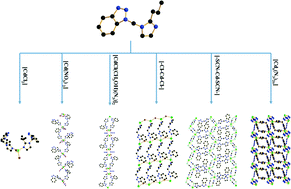Anion-dependent assemblies of a series of Cd(ii) coordination complexes based on an asymmetric multi-dentate ligand and inorganic SBUs: syntheses, crystal structures, and fluorescent properties†
Abstract
Six novel Cd(II) complexes, Cd(bpmi)2Cl2 (1), [Cd(bpmi)2(NO3)2(H2O)]n (2), [Cd2(bpmi)2Cl2(N3)2(CH3OH)2]n (3), [Cd(bpmi)Cl2]n (4), [Cd(bpmi)(SCN)2]n (5) and [Cd(bpmi)(N3)2]n (6), are synthesized by the reaction of different Cd(II) salts with an asymmetric multidentate ligand 1-(benzotriazole-1-methyl)-2-propylimidazole (bpmi). X-ray single-crystal analyses reveal that these complexes show rich structural chemistry ranging from mononuclear (1), one-dimensional (2 and 3), two-dimensional (4 and 5) to three-dimensional (6) structures. These complexes share common features such as they all contain inorganic SBUs and have a high degree of dependence on the corresponding counter anions. In this paper, the fine regulation of counter anions has been discussed in detail. Furthermore, these complexes have been investigated by solid-state UV-vis spectra, thermogravimetric analyses and fluorescence spectra.


 Please wait while we load your content...
Please wait while we load your content...